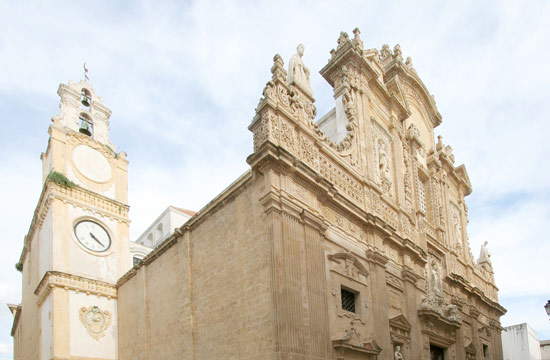Here for you a new guest post by Andrea Congiu, who after telling us about the art of Sardinia, this time takes us to discover the baroque of Lecce... enjoy your reading!
Visiting the Salento region provides an excellent opportunity to immerse oneself in the art of this territory, which is strongly influenced by the presence of the Baroque style to such an extent that it has created its own definition, namely Lecce Baroque, favored in its spread by the presence of Lecce stone, an easily moldable rock that fits perfectly with the geometries of this artistic current, which has seen in the capital of Salento its place of greatest prominence, present in palaces and religious buildings.
 |
| Lecce, the Basilica of Santa Croce. Photo by user Tango7174 from Wikimedia Commons |
But in addition to the Salento capital, dubbed the Florence of the South, Lecce Baroque is present in so many other cities and towns that are part of the province of Lecce. In fact, it is also easily found in the other major cities of Salento such as Otranto and Gallipoli: this was a very important episode that was part of the great art of southern Italy in the seventeenth century.
In a region where natural beauty is a strong draw for mass tourism, the presence of various cultural and artistic destinations is creating a space of increasing relevance among the interests of visitors who travel to Salento, even beyond the classic summer period. For example, recently, a survey conducted by http://www.sanlu.it, an online portal of a hotel near Otranto, listed the presence of artistic destinations as one of the main reasons why tourists chose to travel to the Salento peninsula for a vacation.
In fact, it is increasingly common to see visitors stopping to admire the sights in the city of Lecce, among which stands out as the greatest exponent of the Baroque current is the Basilica of Santa Croce, in whose interior are kept the altars dedicated to St. Francis of Paola and the Holy Cross, defined as the most important works of the Lecce Baroque style. Along the streets of the city it is possible to admire many other buildings recalling this style, including palaces and religious buildings, widespread in the city of Lecce.
 |
| The Cathedral of Gallipoli. Photo by Matthias Kabel |
The use of pietra leccese, a limestone rock that is easily shaped, even with a simple chisel, and capable of giving the works a golden coloring and highly defined details, allowed the style to spread rapidly in Salento, as can also be seen in the city of Gallipoli, which features its Cathedral Basilica of St. Agatha, rich in works created in this style, as well as the Monastery of the Discalced Carmelite nuns, in addition to the vast presence of noble palaces that were built in the period of maximum expression of the Baroque, maintaining its style and canons. The Lecce Baroque style is also popular with tourists in the city of Otranto, which, despite having undergone several restorations of its main buildings over the centuries, manages to retain two important compositions of the style in the Church of Santa Maria dei Martiri.
The Baroque artistic current, which arrived in Salento between the 16th and 18th centuries, blended with the Spanish Plateresque style, marrying to perfection in the realization of works through Lecce stone, coming to create a variant of the style indigenous to the city of Lecce, allowing it to spread rapidly throughout the territory from the Adriatic coast to the Ionian coast, creating a sort of trademark of the artistic heritage of Lecce and Salento.
Tourists, therefore, find in the strong artistic vein of the Salento area a valid alternative to the beauty created and well spread throughout the territory by nature, giving the entire Salento region a leading role even in the sphere of cultural destinations of Italy, where it becomes a pleasure to spend one’s vacation at any time of the year.
Warning: the translation into English of the original Italian article was created using automatic tools. We undertake to review all articles, but we do not guarantee the total absence of inaccuracies in the translation due to the program. You can find the original by clicking on the ITA button. If you find any mistake,please contact us.